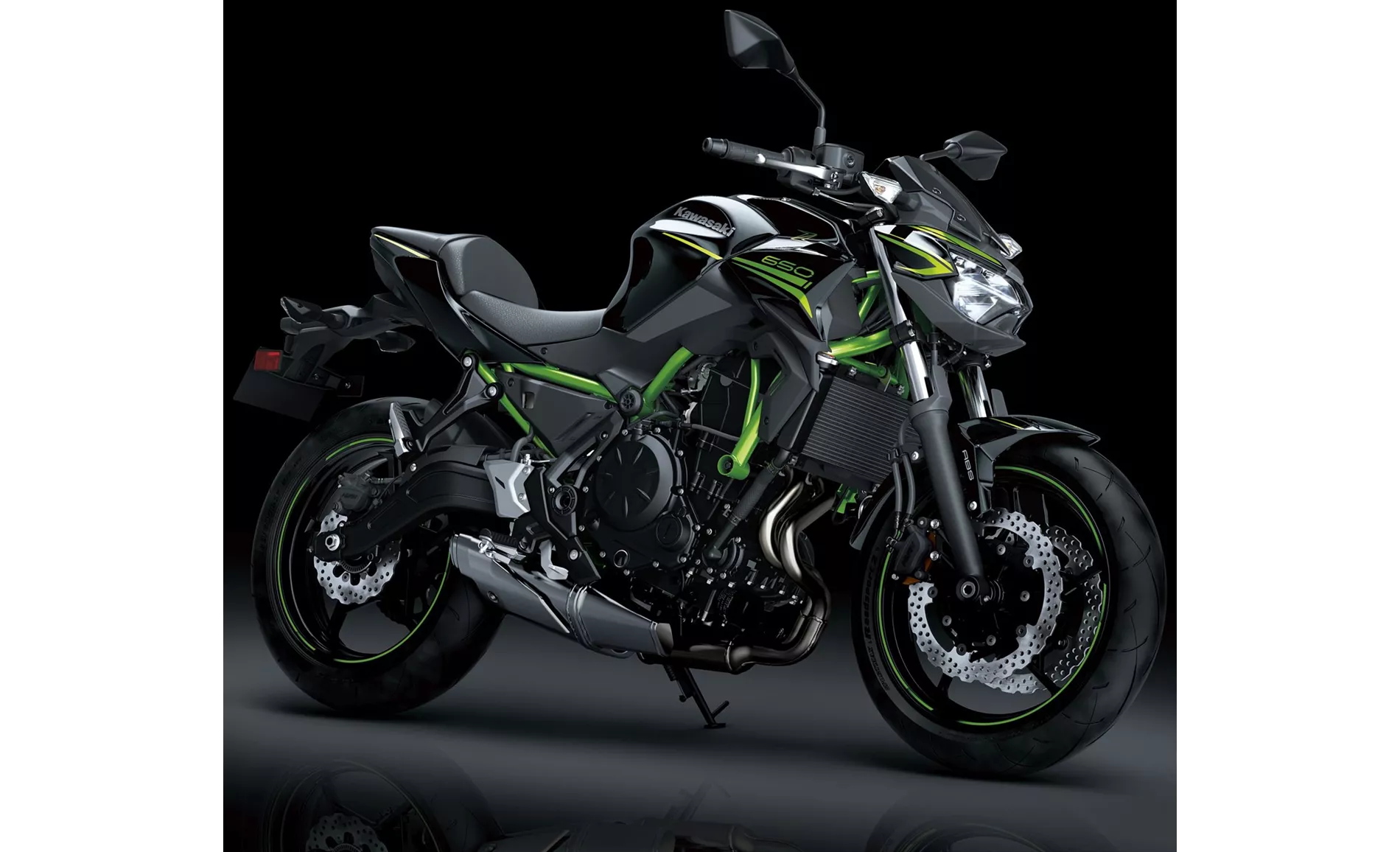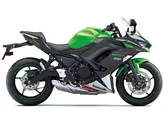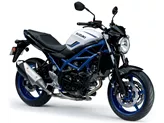Kawasaki Z650 2020 vs. Kawasaki Ninja 400 2023

Kawasaki Z650 2020

Kawasaki Ninja 400 2023
Vue d’ensemble - Kawasaki Z650 2020 vs Kawasaki Ninja 400 2023
The Kawasaki Z650 2020 and the Kawasaki Ninja 400 2023 are both popular models from Kawasaki, but they have some notable differences in terms of technical specifications and strengths.
Starting with the technical specifications, the Kawasaki Z650 2020 is equipped with a powerful inline two-cylinder engine with a displacement of 649cc. It has a bore of 83mm and a stroke of 60mm, resulting in an engine power of 68.2 HP and a torque of 65.7 Nm. The compression ratio is 10.8, and it features a fuel injection system with a throttle bore of 36mm. The Z650 has a liquid cooling system and a 2-cylinder engine configuration with 4 valves per cylinder. It has a steel tubular frame, a front suspension with telescopic fork and a rear suspension with a swing arm and monoshock. The Z650 is equipped with double disk brakes on the front with a diameter of 300mm and double piston technology. It also features ABS as an advanced rider assistance system. The front and rear tires have a width of 120mm and 160mm respectively, both with a diameter of 17 inches. The wheelbase is 1410mm, and the seat height is 790mm. The Z650 has a kerb weight of 187.1kg with ABS and a fuel tank capacity of 15 liters.
On the other hand, the Kawasaki Ninja 400 2023 is a supersport model with a slightly smaller engine. It is also equipped with an inline two-cylinder engine, but with a displacement of 399cc. It has a bore of 70mm and a stroke of 51.8mm, resulting in an engine power of 45 HP and a torque of 37 Nm. The compression ratio is higher at 11.5, and it also features a fuel injection system with a throttle bore of 32mm. The Ninja 400 has a similar cooling system with liquid cooling and a 2-cylinder engine configuration with 4 valves per cylinder. It has the same steel tubular frame, front suspension with telescopic fork, and rear suspension with a swing arm and monoshock. The front brakes are a single disk with a diameter of 310mm and double piston technology. It also features ABS as an advanced rider assistance system. The front and rear tires have a width of 110mm and 150mm respectively, both with a diameter of 17 inches. The wheelbase is slightly shorter at 1370mm, and the seat height is 785mm. The Ninja 400 has a lower kerb weight of 168kg with ABS and a slightly smaller fuel tank capacity of 14 liters.

Kawasaki Z650 2020
In terms of strengths, the Kawasaki Z650 2020 has a powerful two-cylinder engine that delivers a thrilling performance. It also has an aggressive intake noise that adds to the excitement of riding. The Z650 has compact dimensions and a low seat height, making it suitable for riders of different sizes. It has a stable chassis that provides a confident and comfortable ride. The Z650 is also equipped with a TFT display with connectivity, allowing riders to easily access information and control their devices. Additionally, it has a grown-up look that appeals to riders looking for a more mature aesthetic.
On the other hand, the Kawasaki Ninja 400 2023 has a good combination of stability and playful handling. It offers a robust and reliable appearance that instills confidence in riders. The Ninja 400 has a well-controllable engine that delivers power throughout a wide usable rev range. It also offers a pleasant seating position that allows for comfortable long rides.

Kawasaki Ninja 400 2023
However, both models have their weaknesses. The Kawasaki Z650 2020 has been criticized for its front brake pressure point, which may require some adjustment for optimal performance. It is also noted that the Z650 may be uncomfortable for taller riders due to its compact dimensions. Additionally, the Rideology App, which is a connectivity feature, is not considered to be 100% sophisticated.
On the other hand, the Kawasaki Ninja 400 2023 has a limited space for larger pilots, which may not be as comfortable for riders with a taller stature.
In conclusion, the Kawasaki Z650 2020 and the Kawasaki Ninja 400 2023 are both impressive models from Kawasaki, each with its own strengths and weaknesses. The Z650 offers a powerful engine and a grown-up look, while the Ninja 400 provides a good balance of stability and playful handling. Ultimately, the choice between the two models will depend on the rider's preferences and priorities.
Caractéristiques techniques Kawasaki Z650 2020 par rapport à Kawasaki Ninja 400 2023
Avantages et inconvénients en comparaison
Avantages et inconvénients en comparaison
Kawasaki Z650 2020

La nouvelle Z650 de Kawasaki est tout simplement un paquet complet. Les composants techniques ne sont peut-être pas à la hauteur, mais combinés entre eux, ils donnent une moto agréablement neutre, avec laquelle tout le monde aura beaucoup de plaisir. Pas de bizarreries - simplement une moto naked qui fonctionne vraiment bien sur les routes de campagne sinueuses. L'écran TFT, que nous ne trouvons pas encore chez la concurrence, ainsi que l'aspect adulte, qui s'inspire fortement des modèles Z plus grands, sont bien sûr des atouts supplémentaires. Seul le point de pression du frein avant aurait pu être plus clairement défini - mais dans cette catégorie de prix, on ne peut pas tout avoir.
Kawasaki Ninja 400 2023

La Ninja 400 offre un grand plaisir de conduire à un prix raisonnable. Elle offre une maniabilité ludique sans être nerveuse. Le terme "Ninja" est un peu fort, mais son domaine d'utilisation est plus large qu'il n'y paraît. Elle se comporte de manière sportive, mais offre également une bonne position de conduite pour le quotidien et les randonnées.
Comparaison des prix Prix moyen du marché Kawasaki Z650 vs Kawasaki Ninja 400
There are a few key differences between a Kawasaki Z650 2020 and a Kawasaki Ninja 400 2023. In terms of price, the actual average price of a Kawasaki Z650 2020 is about 2% higher. Compared to Kawasaki Ninja 400 2023 there are less Kawasaki Z650 2020 bikes available on the 1000PS.de Marketplace, specifically 21 compared to 73. It takes less time to sell a Kawasaki Z650 with 80 days compared to 165 days for a Kawasaki Ninja 400. Since model year 2017 1000PS.de editors have written 31 reviews for the Kawasaki Z650 and 9 reviews for the Kawasaki Ninja 400 since model year 2018. The first review for the Kawasaki Z650 was published on 11/8/2016 and now has more than 25,000 views. This compares to more than 44,300 views for the first review on Kawasaki Ninja 400 published on 11/22/2017.


















